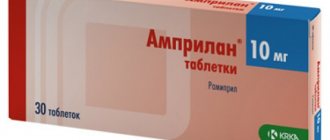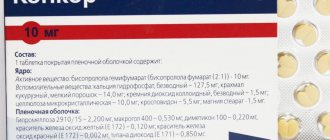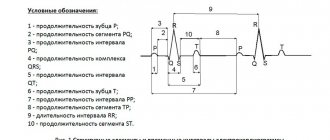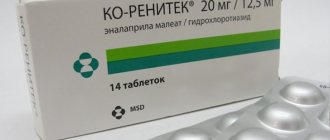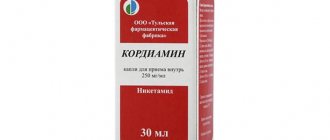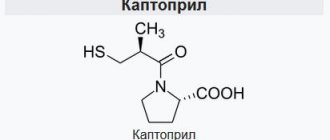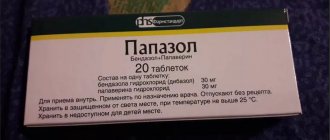Aspecard belongs to the group of antiplatelet agents that prevent platelet aggregation. According to its group affiliation, it is classified as a non-narcotic analgesic. An antiplatelet agent helps reduce the activity of platelets and other enzymes found in the blood. As a result, the likelihood of blood clots decreases. Below is a detailed description of the drug Aspecard 75
, instructions for use, analogues, side effects.
...
After taking the medicine, the cyclooxygenase metabolism of arachidonic acid is blocked. Aspecard has an antithrombotic effect, reduces elevated body temperature, relieves inflammatory processes in the body, and also has analgesic properties.
Indications for use
Aspecard 75 is prescribed to patients after a comprehensive diagnosis. It cannot be purchased without a prescription
from the attending physician. The medicine helps cope with the following health problems:
- fever as the infection progresses in the body;
- severe toothache, migraine;
- neuralgic pathologies;
- cardiac ischemia;
- myocardial disease, heart attack, angina pectoris, heart valve replacement, acute thrombophlebitis, pulmonary infarction.
Important!
The instructions contain information that Aspecard should be taken in increasing dosages to reduce the body's sensitivity to the action of acetylsalicylic acid.
It is indicated for use by people who have been diagnosed with “aspirin triad” and “aspirin” asthma. Aspecard 75 forms tolerance to non-steroidal drugs and relieves the inflammatory process in the body.
This is interesting! For what indications is Piracezin prescribed: instructions for use
Application of medicine
For Aspekard, the instructions for use from the manufacturer are a non-basic guide for the patient to therapy. It does not contain information about the use of the drug for various clinical manifestations, ranging from preventive measures for thrombosis and ending with acute changes in the blood flow of the heart and brain. These types of omissions are a dishonest attitude towards the production of medicines and accompanying information, and the recommended doses differ from each other.
The drug "Aspekard", like other secondary ASA, has an adverse effect on the stomach and intestines. Therefore, the peculiarities of use are that the tablets should be taken after meals, washed down with plenty of water. It would be better if it was a dairy product. This especially applies to patients who suffer from diseases of the stomach and intestines. The quantitative dose of the active substance in the tablets is selected so that only if taken correctly, it can reduce the adverse effect on the gastrointestinal tract.
Patients with bronchial asthma should take Aspecard tablets with extreme caution, in particular if the medication is taken simultaneously with Coumarin or Heparin.
For patients who are prone to allergic diseases, taking the drug can lead to the development of bronchial asthma.
During long-term treatment with the drug, constant monitoring of the blood clotting rate, number of red blood cells, platelets, etc. should be carried out.
Without consulting a specialist, you should not use the medication together with other medications. With uncontrolled use and chaotic combination of medications, serious changes in kidney function often occur.
What's included
Aspecard is produced in tablet form
which are white. They contain acetylsalicylic acid in the amount of 0.1 g. Auxiliary components - croscarmellose sodium, stearic acid, cellulose, colloidal silicon dioxide.
The medicine is presented in pharmacies in a polymer container (100 pieces). There is also packaging in cardboard packages of ten blisters.
Each of them contains 12 tablets. Aspecard is produced by Ukrainian pharmaceutical company.
Overdose and its signs
A mild degree of poisoning, which is caused by taking the drug not as prescribed by a specialist, is manifested by the following symptoms:
- dizzy;
- pain in the area of the pit of the stomach, around the navel;
- Possible lower back pain (often in people with kidney problems).
If you exceed the dose or use the medication for a long time, bleeding occurs in the stomach and intestines. Serious changes in the functioning of the kidneys and liver also occur. The larynx swells, azotemia, papillary necrosis, and aseptic meningitis develop.
In case of mild poisoning, the first thing to do is to induce vomiting using plenty of cold drink, taking activated carbon, enterosorbent, and also take the person to the hospital.
The instructions do not specify toxic doses of the medication. They differ depending on the age and height of the patient. The occurrence of a significant overdose in an adult is observed when consuming 7–9 grams of tablets, and in children – 2–2.5 grams. Overdose is manifested by such disorders as:
- confused thinking;
- noise in ears;
- slurred speech.
Frequent vomiting occurs, during which the patient loses fluid. His breathing quickens, acute urinary retention occurs, and his temperature increases.
With such symptoms, it will not be possible to help the victim on your own. It is necessary to take him to the hospital for infusion treatment with lactate, sodium bicarbonate.
In case of overdose, the following is also noted:
- salicylic syndrome;
- spasms;
- numbness;
- to whom;
- sharp degradation;
- swelling of the lungs;
- state of shock;
- renal failure.
How to take Aspecard 75
Before taking Aspecard 75, the instructions for use must be read. The recommended dose is 1 tablet once a day after meals. The medicine is washed down with water. The instructions indicate that the tablets can be taken with milk. It will help reduce irritation and the effects of the drug components on the mucous membrane of the digestive tract.
This is interesting! How to take Piracetam tablets: instructions for use
To reduce the clinical manifestations of pain, including the progression of the inflammatory form of genesis, the daily dose is 3 g. With the progression of rheumatic pathologies, adults are prescribed a daily dosage of up to 4 g. The medicine is prescribed to children in isolated cases. The dosage is calculated depending on age. For each year of life you need to add 0.2 grams.
Important!
To prevent recurrence of myocardial infarction, the dose can be increased to two tablets per day.
The maximum permissible daily dose for adults is 300 mg of the drug. Effervescent tablets are sold in blisters, which are dissolved in half a glass of water. The finished medicine is consumed after meals
.
Duration of taking Aspecard
Aspecard can be taken for a long time.
Patients are recommended to use it for 1-2 years to prevent heart and vascular diseases. Doctors prescribe one tablet per day.
For intensive treatment, one tablet is prescribed 3 times a day .
The duration of such therapy is 4-5 days.
Before you start taking it, you need to visit a specialist who will definitely study the indications and individual characteristics of the body.
Taking Aspecard for blood thinning
This unpleasant phenomenon is encountered by people with an elevated platelet count. As a result of this deviation, the blood begins to become thicker, and there is a possibility of clots forming. They can clog blood vessels. To thin the blood you need to take 0.5 g. in the morning and evening.
Attention!
Aspecard should be in the first aid kit of persons whose blood composition is periodically disturbed.
The drug is prescribed for the prevention of angina pectoris
. Before taking, you should consult a doctor. After studying the diagnostic results, he will determine the timing of therapy and treatment regimen. The specialist takes into account the individual characteristics of each person’s body, indications for use and the severity of the disease.
This is interesting! How to take Asparkam tablets correctly? Instructions for use
Instructions for use of the drug
The active substance of Aspecarda - ASA - belongs to the class of non-steroidal anti-inflammatory drugs (NSAIDs) with antithrombotic properties.
The effect of blood thinning is due to the effect on the adhesive (“stick” to the vascular wall) and aggregation (stick together) capabilities of platelets. Features of drug metabolism in the body:
- bioavailability (the amount of drug that is delivered to sensitive structures) - 40-50%;
- half-life from blood plasma – 20 minutes;
- the active substance begins to act a few minutes after absorption in the digestive tract;
- the maximum effect is determined in the portal system (vessels carrying blood from the intestinal wall to the liver).
“Aspecard” causes irreversible dysfunction of the platelet (for the entire life of the “blood plate”).
Indications
"Aspecard" is used to reduce the risk of cardiovascular "catastrophes" (stroke, myocardial infarction) for:
- acute coronary syndrome (ACS);
- rehabilitation of post-infarction patients;
- transient cerebral blood flow disorders (TIA) and stroke;
- angina pectoris: unstable, tension;
- diabetes mellitus type II;
- metabolic syndrome;
- obesity;
- hyperlipidemia, atherosclerosis;
- hypertension;
- in elderly patients.
Indications for the use of Aspekard for preventive purposes:
- postoperative thromboembolism (with vascular interventions: transluminal angioplasty, endarterectomy, coronary artery and arterioveous bypass surgery);
- venous thrombosis and TELA (pulmonary embolism) in patients with forced long-term immobilization (immobilization after trauma, abdominal surgery, paralysis);
- prevention of repeated occlusions (narrowing of the lumen) of cerebral vessels.
Mechanism of action and composition
1 tablet of Aspekarda contains 100 mg of ASA. There is no strip on the surface of the drug, so it cannot be divided in half or chewed.
ASA, by acetylation, blocks the activity of cyclooxygenases (COX) in platelets. The pharmacological effects of the interaction are presented in the table.
| Effects | Clinical significance |
| Decreased synthesis of prostaglandin endoperoxides (PGH2, PGD2) | Blockade of the inflammatory cascade |
| Inhibition of thromboxane A2 and arachidonic acid production | Prevention of increased blood clot formation |
| Reduces the formation of prostacyclins | Expands the lumen of blood vessels, improves the rheological properties of blood |
| Stimulation of transcription in genetic material | Synthesis of anti-inflammatory mediators |
| Decreased ability to oxygenate lipoprotein complexes | Prevention of atherosclerosis |
| Increases ferritin synthesis | Increasing the oxygen capacity of the blood, improving iron metabolism |
| Induction of production and release of adenosine, P-selectin, endothelial growth factor | Anti-inflammatory effect |
The disaggregation effect of Aspecard is based on the inhibition of COX-1 of platelet membranes and the thromboxane activation mechanism.
Additional cardioprotective effects are due to the ability of ASA to stimulate the formation of proresolution mediators - substances that:
- eliminate signs of aseptic inflammation;
- promote tissue regeneration (restoration);
- influence the exchange of NO synthetase in the vascular endothelium with the subsequent release of nitric oxide, a molecule that expands the lumen of the arteries.
Acetylation of COX-2 changes the structure of the molecule, converting it into lipoxygenase. After enzymatic transformation, “aspirin-induced” lipoxin is formed, which has anti-inflammatory properties and enhances reverse cholesterol transport.
Increasing the dose of Aspecard does not affect the antiplatelet properties, but increases the risk of adverse reactions.
Directions for use and doses
The concentration of the active substance in Aspekard is designed for a single dose.
Recommendations for use:
- take the tablet 30 minutes to an hour before meals;
- drink plenty of fluids (to reduce the risk of gastrointestinal side effects);
- use the drug in the evening.
The latter is explained by the circadian rhythms of platelet aggregation (peak activity occurs at 22 hours).
The standard dose for the prevention of cardiovascular accidents is 100-200 mg/day for 1 month with further revision of the dosage of the drug and the presence of indications for continued ASA therapy. Alternative regimen: 300 mg of Aspecard once every 48 hours.
Recommendations of the American Heart Association for ACS and unstable angina:
- start therapy with ASA at a dose of 150-325 mg as early as possible;
- transition to maintenance treatment at 75-150 mg/day.
Such a system reduces cardiovascular mortality by 23% from repeated myocardial infarction and by 50-70% from fatal arrhythmias in the acute phase.
To prevent recurrent strokes, it is recommended to start treatment with Aspecard 24-48 hours after the onset of symptoms. If the patient is planning to undergo thrombolytic therapy, the use of ASA should be delayed for 24 hours.
Contraindications and symptoms of overdose
The use of Aspecard is contraindicated for:
- hypersensitivity to ASA and other salicylates;
- aspirin-induced bronchial asthma;
- patients with a history of asthma attacks after using other NSAIDs;
- acute ulcers of the digestive tract (including Crohn's disease, colitis);
- hemorrhagic diathesis;
- end-stage renal failure;
- severe liver dysfunction;
- high degree of circulatory failure;
- when taken together with Methotrexate at a dosage of more than 15 mg/week (the combination increases hematological toxicity);
It is not recommended to take Aspecard in the first and third trimesters of pregnancy. Up to 12 weeks, the use of high doses of ASA (more than 100 mg/day) increases the likelihood of arbitrary abortion and the birth of a child with developmental anomalies:
- gastroschisis - incomplete rotation of the intestine in the embryonic period with non-fusion of the anterior abdominal wall;
- “cleft palate” – a cleft in the hard palate;
- spina bifida;
- heart defects;
- diaphragmatic hernia;
- hypospadias in boys.
In the third trimester, Acetylsalicylic acid provokes premature closure of the ductus arteriosus with the development of cardiopulmonary failure, kidney damage in the fetus, weakness of labor, postpartum hemorrhage, and the formation of cephalohematoma in the newborn. Low-dose ASA should be discontinued 4 weeks before delivery.
Long-term use of high doses of ASA is accompanied by the risk of chronic salicylate intoxication. Symptoms of drug overdose:
- vertigo (dizziness);
- noise, ringing, buzzing in the ears;
- dyspepsia (indigestion);
- migraine;
- increased sweating;
- disturbance of consciousness;
- acid-base imbalance (shift to the acidic side);
- hyperventilation, pulmonary edema;
- increased bleeding;
- renal dysfunction.
Therapy for “salicylicism” includes gastric lavage, sorbents, forced diuresis and correction of the acid-base state.
Treatment of hemorrhagic complications from the gastrointestinal tract is carried out in a surgical hospital.
special instructions
"Aspekard" is prescribed with caution to patients with:
- allergies to painkillers, anti-inflammatory, antirheumatic drugs;
- history of ulcerative lesions of the digestive tract;
- with simultaneous treatment with direct anticoagulants (Heparin, Fraxiparin);
- circulatory disorders: renal vascular pathologies, congestive heart failure, massive surgical interventions, blood loss;
- lack of glucose-6-phosphate dehydrogenase enzymes (high probability of hemolysis);
- liver failure.
The combined use of ASA with Ibuprofen enhances the antithrombotic effect.
In patients with gout, Aspecard causes an exacerbation of the process due to a delay in the excretion of uric acid.
The use of ASA during fever in children with acute respiratory viral infections provokes the development of Ray's syndrome (severe liver damage).
Long-term use of drugs containing ASA increases the risk of gastropathy. Therefore, parallel use of H2-blockers or PPIs (Ranitidine, Omeprazole) is recommended. Recent studies have shown that the combined use of ASA and nitrates equally reduces the risk of damage to the gastric mucosa, as do H2 blockers.
ASA is protected from the ulcerogenic effect by an enteric coating, which prevents the acid from affecting the stomach. In such forms, the onset of drug release is delayed by 2 hours, which is not suitable for providing assistance in emergency situations.
Contraindications
Aspecard 75 is contraindicated in persons who have been diagnosed with the following health problems:
- hemophilia;
- blood clotting disorders (this includes various types of pathology, including diathesis, hypocoagulation);
- renal and liver failure;
- erosive damage to the gastrointestinal mucosa;
- individual intolerance or hypersensitivity to acetylsalicylic acid, as well as additional components that are included in the composition.
Pregnancy and breastfeeding of a child and age under 14 years are usually also contraindications to prescribing and taking the medicine.
In childhood, during pregnancy and breastfeeding
Aspecard tablets are contraindicated during pregnancy, since acetylsalicylic acid quickly penetrates the amniotic fluid and can affect the intrauterine development of the child.
Breastfeeding is discontinued while taking the drug.
Due to the possible development of Reye's syndrome, Aspecard is not used in children and adolescents under 16 years of age, except for special indications.
Analogues of the drug Aspecard
Pharmacies offer a wide selection of medicines that are analogues of Aspecard
. Below is a table with detailed descriptions.
| Analogs | Detailed description |
| Magnicor | This is a combination drug that contains magnesium hydroxide and acetylsalicylic acid. The drug quickly relieves pain, inflammation, and has an antipyretic effect. The main substance and auxiliary components are quickly absorbed in the gastrointestinal tract. |
| Cardiomagnyl | Indicated for use by persons who have been diagnosed with thrombosis. Helps reduce the clinical manifestations of ischemia and angina. The drug can be used to prevent heart failure, which occurs as a result of obesity, alcohol abuse or old age. |
| Acekor cardio | Has a good antithrombotic effect. The main substance in the composition is acetylsalicylic acid. The tablets are covered with a white coating, which quickly dissolves after entering the gastrointestinal tract. |
| Lospirin | Effectively eliminates the symptoms of fever, has a positive effect on inflamed areas inside the body. It is prescribed for unstable angina to reduce the likelihood of death from myocardial infarction. |
| Godasal | Indicated for use in heart diseases, in particular acute myocardial infarction, angina pectoris, stroke, ischemic attacks. Relieves inflammation, soreness and heat. |
Overdose
Chronic poisoning with salicylates is possible when taking more than 100 mg/kg body weight per day for more than 2 days in a row. The toxic effect can also be hidden and life-threatening. Symptoms include ringing in the ears, dizziness, deafness, nausea, increased sweating, vomiting, confusion, and headache. Metabolic acidosis appears in children.
Article on the topic: How to increase potency in men at home quickly and for a long time?
Treatment of acute poisoning is aimed at removing the drug from the blood and restoring the electrolyte and acid-base balance. Gastric lavage, taking sorbents, forced alkaline diuresis, and hemodialysis are indicated.
Which is better: Aspecard or Cardiomagnyl
Many people ask doctors: which is better: Aspecard or Cardiomagnyl
. Experts say that the drugs have the same pharmacological effect.
They are prescribed to people whose coronary vessels are blocked due to increased blood clotting. The presented drugs have the same indications for use.
They are prescribed to prevent the formation of thrombosis, reduce attacks with progression of angina pectoris, heart failure. They may be used in selected cases after surgery to prevent the development of thromboembolism .
Cardiomagnyl contains magnesium hydroxide and acetylsalicylic acid. When used correctly and in compliance with the dosage, the medicine lowers elevated body temperature, relieves pain, and also has an antiplatelet effect. It can be taken for a long time as a preventive measure.
This is interesting! How to take Mildronate tablets: instructions for use
Pharmacological properties
Aspecard 100 tablets provide:
- antipyretic effect at elevated body temperature;
- anti-inflammatory and analgesic effect in rheumatic diseases;
- antithrombolytic effect in the treatment and prevention of blood clots.
Pharmacodynamics and pharmacokinetics
By irreversibly inhibiting the enzyme cyclooxygenase, the union of prostaglandins is inhibited. Thanks to this process, the production of thromboxanes is reduced, the lumen of blood vessels expands and the gluing of platelets into clots is minimized. This increases the secretion of prostacyclins, which prevent platelets from attaching to the walls of blood vessels.
Excipients prolong the action of the main substance and reduce the local irritating effect on the mucous membrane of the stomach and esophagus.
Absorbed in the walls of the intestines and liver. The maximum concentration of the substance in the blood reaches 2.5-3 hours after administration.
It is excreted from the body by the kidneys and in small quantities through breast milk.
Side effects
In extremely rare cases, patients may experience the following side effects:
- colic in the intestines, internal bleeding inside the gastrointestinal tract, vomiting;
- signs of anemia and pale skin;
- improper functioning of the kidneys;
- internal bleeding in the brain, bleeding gums;
- spasms in the bronchi;
- itching, swelling, redness of the skin;
- anaphylactic shock and rhinitis.
If such symptoms appear, you should immediately stop further use of the drug Aspecard 75 and seek help from a doctor. If your health suddenly deteriorates, you should call an ambulance.
Aspecard - use of the drug
Side effects of Aspecard
Aspecard may cause side effects such as:
- Diarrhea, nausea, vomiting, abdominal pain, erosive and ulcerative lesions of the stomach, microhemorrhage, gastric bleeding, discomfort in the epigastric region;
- Thrombocytopenia and anemia;
- Impaired kidney and liver function;
- Allergic reactions, namely urticaria, skin rash and itching;
- Hypoglycemia.
With prolonged use of the drug, negative changes such as nephrotic syndrome, edema, blood diseases, aseptic meningitis, interstitial nephritis, and papillary neurosis sometimes occur.
Suspension during pregnancy or breastfeeding
Be careful to prevent salicylation during the 1st and 2nd trimesters of pregnancy. The use of salicylates is contraindicated during the third trimester of pregnancy.
Inhibition of the synthesis of prostaglandins can negatively affect vaginity and/or embryonic/intrauterine development. These data indicate a risk of cardiac failure, cardiac malformation and gastroschisis after administration of inhibitors of prostaglandin synthesis on the beginning of vaginosis. The risk progresses steadily as the dose increases and the severity of therapy increases.
The data do not confirm a connection between the stagnation of acetylsalicylic acid and the excretory rhizome. In view of the fact that this is not the case today, due to the risk of gastroschisis, it is impossible to switch off when using stagnant acetylsalicylic acid.
During the first and second trimesters of pregnancy, drugs that replace acetylsalicylic acid should not be prescribed without a clear clinical need. For women who are likely to be pregnant and for those who are pregnant in the 1st and 2nd trimesters, the dose of drugs that replace acetylsalicylic acid will be low, and the duration of treatment will be short.
Occasions of implantation failure, embryotoxic and fetotoxic infusions, and infusions prior to pregnancy following prenatal exposure to salicylates have been reported.
It appears that stagnation of salicylates in animals causes adverse reactions in the fetus (such as increased mortality, growth disorders, salicylate intoxication), but controlled studies have been carried out on the participation of pregnant women. was not carried out.
According to preliminary evidence, the risk is low when the drug is administered at therapeutic doses.
During the third trimester of pregnancy, all inhibitors of prostaglandin synthesis can be added to the pregnancy as follows:
- cardiac-legeneva toxicity (from initial closure of the arterial duct and pulmonary hypertension) and/or impaired function with possible further development of nicotine deficiency with oligohydramnios;
- Decreasing the time of bleeding, antiaggregation infusion that can occur in the woman and fetus due to gestation;
- As time goes by, bleeding is also more likely when even low doses are administered;
- quick galvanization of the uterus and bleeding in the vaginal area and deepening of the canopy.
Importantly, acetylsalicylic acid is contraindicated in the third trimester of pregnancy.
Salicylates consume breast milk. Concentrations in breast milk are equivalent or perhaps higher than concentrations in maternal blood plasma.
Under the hour of prescribed ingestion for indications under the hour of lactation, administer breastfeeding at regular intervals of high doses (> 300 mg/day).
Overdose
Symptoms of severe illness may develop gradually, for example, 12–24 years after the illness. After an oral dose of ASA up to 150 mg/kg body weight, a moderate level of intoxication may develop, and with a dose > 300 mg/kg body weight, a severe level of intoxication may develop.
Chronic salicylate toxicity may cause symptoms, although the symptoms are nonspecific. Mild chronic intoxication worsens, as a rule, only after repeated doses of large doses.
Acute intoxication is indicated by a change in the acid-salt balance, which can vary depending on the age of the patient and the severity of intoxication. Its most common manifestation in children is metabolic acidosis. The severity of the disease cannot be assessed without considering the concentration of salicylates in the plasma. Absorption of acetylsalicylic acid may be increased in the case of ligation from the sealing of the plug, molding of stones from the plug, or in the form of tablets, sealed with the intestinal membrane.
Closed.
Local signs of discomfort that may dominate with overdose of ASA, such as boredom, vomiting and pain in the pouch, may be daily fragments given the medicinal form of ASA may damage the intestinal lining and resorption will occur. only in the small intestine.
Symptoms:
headache, fatigue, hypocalcemia or hypoglycemia, skinny visip, confusion, intestinal bleeding, suppression of thrombus formation to coagulopathy, cardiovascular disorders (such as arrhythmia, arterial general hypotension to the heart rate), tinitis, impaired vision and hearing, tremor, confusion , hyperthermia, excessive sweating, hyperventilation, disruption of acid-salt water and electrolyte imbalance, anemia, coma and respiratory failure.
Tingling in the ears is possible when the concentration of salicylates in blood plasma is above 150–300 mcg/ml. Serious adverse reactions are avoided at plasma concentrations of salicylates greater than 300 mcg/ml.
Therapy. Through life-threatening conditions in the wake of severe intoxication, it is important to take all the necessary steps: prevention or decreased resorption, washing the mucus in the early stages (up to one years after taking it), activation of vugilla, control and proper correction of electrolytes. Stagnation of glucose. Sodium bicarbonate to correct acidosis and accelerate elimination (pH > 8). Glycine: initial dose - 8 g orally, then - 4 g skin dose for 2 years for 16 years. Hemoperfusion or hemodialysis are possible (the need for infusion may be determined by a poison control center).
